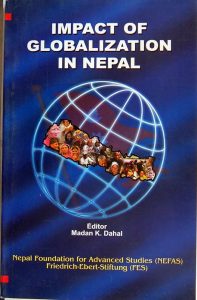-Trade Union Perspective-
Professor Dev Raj Dahal
Kathmandu, Nepal

GLOBALIZATION MEANS free flow of ideas, goods and services in the world. Its critical components – economy, technology and information – function independent of the control of the nation-states and regions. The magnitude of the conceptual and political change brought by it is so profound that the governments have to redefine their traditional notions of sovereignty and legitimacy in governing the people. Globalization has equally caused the decline of territorial state as a critical actor – as an employer, regulator and a means for allocating national products through taxation and tariffs. Today, national government alone cannot oxandrolone it face the challenges presented by a borderless economic system. The inability of the state to regulate international flows of capital brings with it an equal loss of authority over all the national institutions: legislatures, political parties, trade unions, human right organizations and civil society.
The information revolution is overwhelming the barriers of time and pace and opening the doors to communication, computers, corporations and financial interests to run across the national borders. The globalization process has thus inspired a reexamination of regulatory structures to coordinate the global and regional dimensions of problems and issues. In this context, it will be pertinent to examine the impact of globalization in Nepal in general and the Nepalese workers in particular. This article attempts briefly to address macro-economy and globalization drive, impacts on key sectors of political economy including labor market, foreign investment, problems in industrial relations, and challenges to trade unions in Nepal. This article, however, does not deal either with the theoretical or historical aspects of globalization.
Macro-Economy and Globalization Drive:
Nepal is one of the poorest countries of the world with a per capita income of $ 200. More than fifty percent of its nearly 21 million population is below poverty line. If the current growth rate (2.5 percent) of population continues, the population of Nepal will reach 40 million by the year 2020. The average annual GNP growth rate of 3.
4 percent roughly balances the population growth rate. An ominous trend is that Nepal’s food grain production is not enough to feed the population. The population growth is higher than food grain production (2.2 percent) thus posing an impending crisis of sustainable livelihoods of the people. The Ninth Plan (1997-2002) expects to accelerate economic growth to an average of 6.
5 percent.
More than 60 percent of its development budget comes from foreign aid and, consequently, aid constitutes a major instrument for Nepal to escape from weak income, poor savings, and low investment trap. As mobilization of domestic resources is disappointing, reducing aid dependency does not seem plausible. The growing fiscal deficit gap in the economy indicates a trend towards debt spiral. Debt servicing is the single largest item of regular expenditure and it is so huge that even four years of revenue collection cannot pay back the debt. The size of foreign debt which was 16 percent of GDP till the mid-eighties has increased to above 55 percent by the mid-1990.
The govemment’s spending on social sector is barely 2.5 percent of the national income while donors’ share is 6.5 percent. When the economic performance of the country translates into poverty, lack of opportunity, unemployment and inflation – it does touch the lives of ordinary people.
_____________________________________________________________________________
“GLOBALIZATION MEANS free flow of ideas, goods and services in the world. Its critical components – economy, technology and information – function independent of the control of the nation-states and regions. The magnitude of the conceptual and political change brought by it is so profound that the governments have to redefine their traditional notions of sovereignty and legitimacy in governing the people.”
_______________________________________________________________________________
Until the first half of the 1980s, Nepali state has been active in the Sphere of production, regulation; circulation and control. The state expanded not Because of the increased demand for public goods, but because ownership of these resources was presumed to be a vital instrument of its sovereignty and command over the loyalty of citizens. This does not mean that the state is now heavily burdened: for, the share of public sector output in Gross Domestic Product GDP is less than 10 percent. The most disturbing Development of globalization is the changing role of government from active partner and balancer of employer, employees and government to that of a passive spectator. The welfare outcome of social expenditure of government is highly skewed because of urban bias in planning and development.

In the late 1980s, the low economic growth led to a severe macroeconomic instability in the country such as growing fiscal deficits and declining international reserves. In this context, major donor countries and international financial institutions, such as the World Bank and the International Monetary Fund (IMF) began to set Nepal’s development priorities and prescribed to the government embracing market-based economic growth as well as opening itself to international capital flow. The ideological motive of the market economy was to free the economy from the state and release economic forces to participate in the process of global development. With no option, the government had to adopt a Stabilization Program in 1985, sponsored by the International Monetary Fund (IMF), and a Structural Adjustment Program (SAP) financed by the World Bank and by IMF Structural Adjustment Facility for 1987-90. The deeper causes for Nepal to adopt stabilization and adjustment programs are:
# Growth rate of GDP has skidded into near-stagnation, increasing fiscal deficit of the state owing to low internal revenue mobilization, fast growing public expenditure and swelling debt burden;
# Inefficiency of public sector enterprises despite heavy subsidies granted by the state and corrupt practices plaguing the core of the political economy of public institutions. On average “about half of the public enterprises have been making losses; and when the few larger enterprises making significant profits are excluded, the rate of return on net capital employed in other public enterprises has been consistently negative” (World Bank, 1997:6);
# Inability of the state-owned banks to recover significant portion of their loans and the persistence of negative real interest rates;
# Poor performance of industrial and agriculture sectors with low capacity utilization, low quality products, lack of competition, protectionist industrial policy, bureaucratic delay, corruption, etc.:
# Growth in imports outpacing exports causing a widening current account deficit and a sharp drop in foreign exchange reserve; and,
# Widening poverty, inequality, unemployment, and chronic underemployment in Nepal.
###########################################################################
“In the late 1980s, the low economic growth led to a severe macroeconomic instability in the country such as growing fiscal deficits and declining international reserves. In this context, major donor countries and international financial institutions, such as the World Bank and the International Monetary Fund (IMF) began to set Nepal’s development priorities and prescribed to the government embracing market-based economic growth as well as opening itself to international capital flow.”
####################################################################

Adjustment aimed to achieve macro-economic stabilization, increased resource mobilization, investment efficiency, better financial management public enterprises, increased productivity and employment in agriculture pastor through increased private sector involvement in agriculture, trade, industry and forestry. As the second phase of SAP expired in 1990, lie country experienced a political change from party less Panchayat system to multi-party democracy. In 1992, Nepal entered into another phase of the Enhanced Structural Adjustment Facility (ESAF) of the IMF with the objectives of raising GDP growth to about 5 percent annually in the next three years; reducing annual inflation to 5 percent, limiting current account deficit to 9.6 percent of GDP; and reducing fiscal deficit to 7.8 percent of the GDP by the end of 1995.
Liberalization process has been robustly pushed by the first elected government of Nepali Congress in 1991 despite its avowed ideology of democratic socialism. The government enacted the Privatization Act 1991 and accompanying regulations and guidelines with the objectives of reducing the burden on the government and releasing resources to other sectors; generating the operational efficiency and productivity of the enterprises; and encouraging private sector involvement in business and industries. Liberalization subsumed: the financial sector reforms including the full convertibility of the Nepalese currency on current accounts; simplification of licensing procedure for trade and industry, promulgation of New Industrial Policy 1992, Industrial Enterprises Act 1992, Foreign Investment and Technology Transfer Act 1992, One Window Policy, de-bureaucratization, privatization (also denationalization of some) of thirteen public enterprises (PEs) comprising industry, trade and services sectors in addition to the liquidation of two PEs with total employees of more than three thousands either through selling of business and assets or selling bulk of shares to business group. It also allowed private sector investments in hydro-electricity, civil aviation, banking, fertilizer supply, etc.
Previously, the state enjoyed an absolute sovereignty over these sectors. In the industrial sector, it was a paradigm shift from the inward-looking, protectionist and import-substituting strategies towards outward-oriented, competitive liberal economic policies. The idea was to unleash tie creative entrepreneurial spirit of the industrial class and break the existing monopoly of the comprador class who thrived on their nexus with the bureaucracy and politicians and exploited the consumers and workers by conducting underground business through the open border with India and garnering various trading, exchange rates and tax benefits.
End text.
# Text Courtesy: “Impact of Globlisation in Nepal”, Published by the Nepal Foundation of Advanced Studies (NEFAS) /Friedruich Ebert Stiftung (FES), 2005.
Editor: Professor Dr. Madan Kumar Dahal (Late).
# Thanks the NEFAS/FES.
# Shortly to begin with “Impacts on Key Sectors of the Political Economy”.
# published with the special permission from th author Dev Raj dahal: Ed. Upadhyaya.
